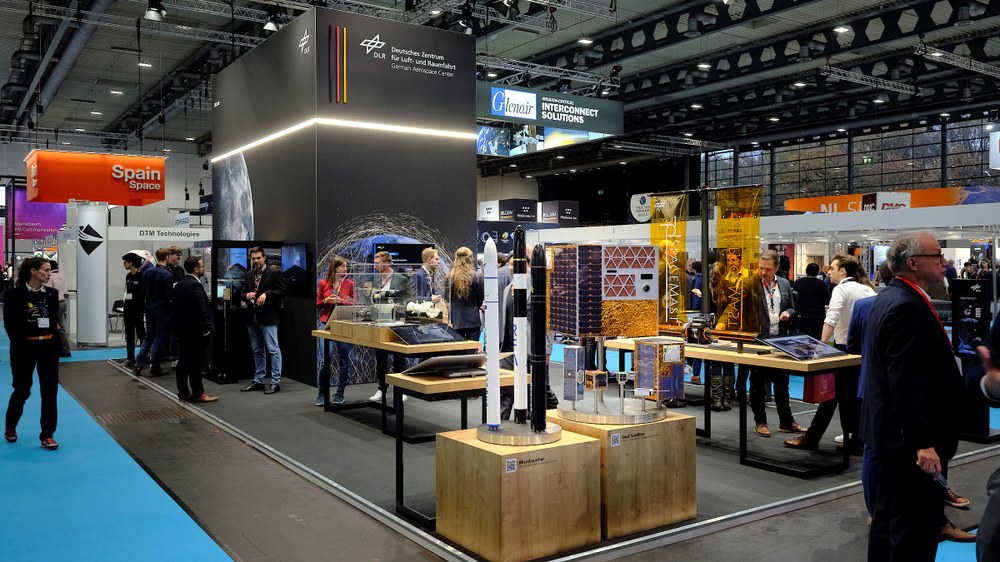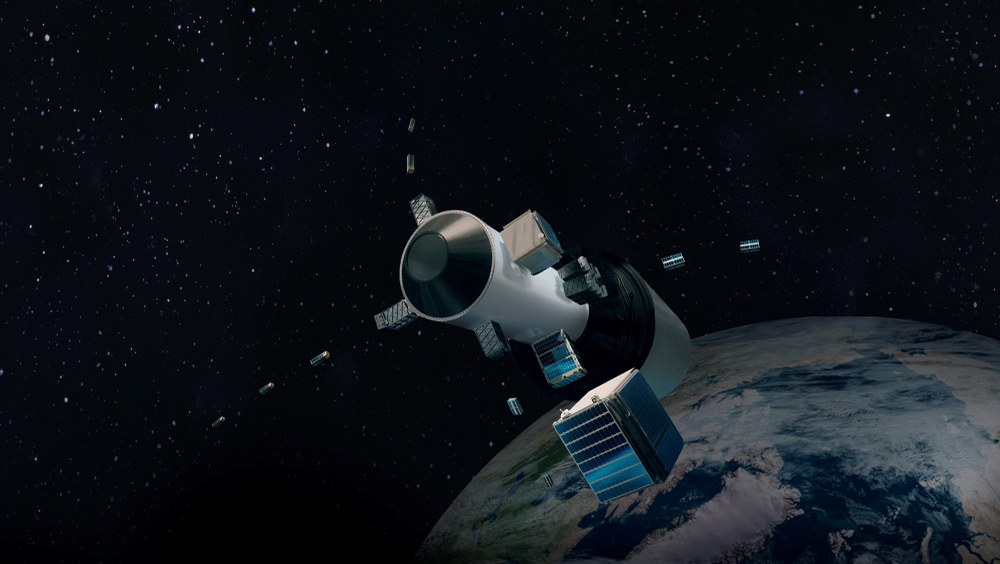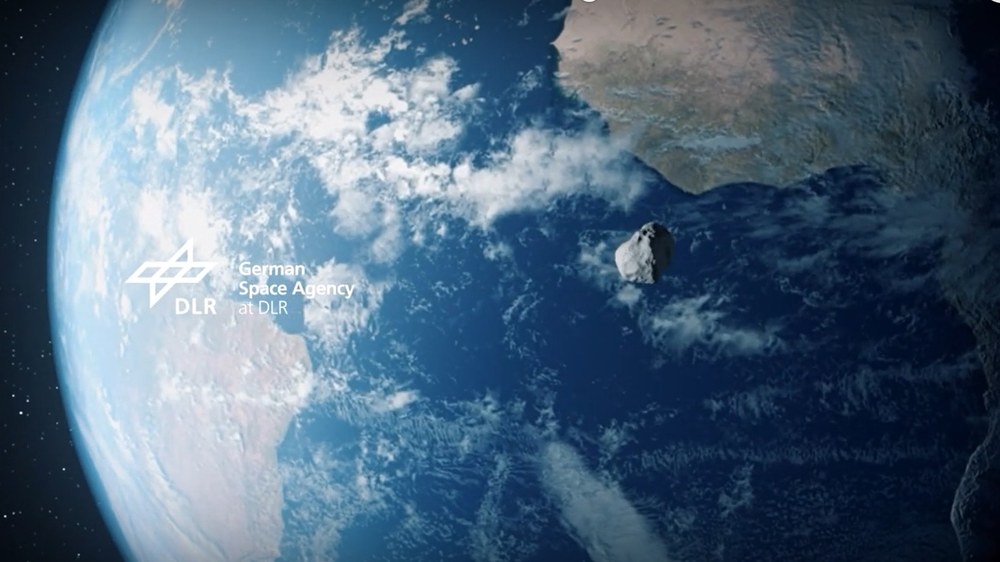DLR showcases space innovations at Space Tech Expo 2024 in Bremen



- The DLR stand is located in Hall 5, stand number J28.
- At the Space Tech Expo, DLR is providing insights into its space research.
- The focus is on space technologies, components and innovations, as well as projects in cooperation with industry.
- Focus: Space, space agency, technology transfer
The German Aerospace Center (Deutsche Zentrum für Luft- und Raumfahrt; DLR) is participating in the Space Tech Expo from 19 to 21 November 2024 in Bremen. At the exhibition stand in Hall 5, stand number J28, DLR and the German Space Agency at DLR will be presenting current space missions, exhibits from space research and transfer topics that are finding their way from research into application. Visitors also have the opportunity to experience a virtual spaceflight in the German Space Agency at DLR's SPACEBUZZ ONE.
"At this year's Space Tech Expo Bremen, we are presenting three spin-off projects demonstrating the innovative capacity of space research at DLR,” says Anke Pagels-Kerp, DLR Divisional Board Member for Space. "From the flexible and versatile SpaceMast to propulsion technologies for environmentally compatible fuel combinations and components for optical communication technologies, we are showing how DLR turns research ideas into start-ups that launch new technologies into space."
"The Space Tech Expo in Bremen is a marketplace for the European space industry. This is where small- and medium-sized enterprises (SMEs) meet system integrators and anchor customers," emphasises Walther Pelzer, DLR Executive Board Member and Director General of the German Space Agency at DLR. "Microlaunchers have also become part of this European space landscape. I am particularly pleased that, together with the Federal Ministry for Economic Affairs and Climate Action, we have been able to provide additional funding in ESA's Boost! programme to further advance the development of launch services in Germany and Europe, which are driven by the private sector, and thus also to support the implementation of the European Launcher Challenge."
Emerging market for small satellites and microlaunchers
Small satellites weighing up to 500 kilograms play a crucial role in the emerging space market. According to forecasts, more than 10,000 small satellites will be launched into space by 2030. They can be used in various ways – for telecommunications services, Earth observation and climate research, or to test new technologies in space. In addition, they can be produced in larger numbers and therefore more quickly and cost-effectively than conventional satellites. Rocket models in miniature format from the German startups Isar Aerospace Technologies SE (Spectrum launcher), Rocket Factory Augsburg AG (RFA One) and HyImpulse Technologies GmbH (SL1) will be on display at the trade fair. ESA is supporting these and other initiatives with its Boost! programme. The programme has now shifted funds totalling 16.67 million euros and released an additional 20 million euros in German funds. These funds will be used to support the aforementioned companies, in equal parts, to advance the inaugural flight campaigns of their microlaunchers.
To advance the development and production of small satellites and microlaunchers for the German economy, the German Space Agency at DLR has organised three competitions: the microlauncher payload competition, and, most recently, the Small Satellite Competition and the Small Satellite Payload Competition. The winners of the last two competitions will be awarded a ride on one of the German microlaunchers.
Components for satellite communication
Smart-Retro® consists of a retroreflector and polarisation optics, which can be attached to traditional satellites as well as to very small satellites the size of a shoebox, known as CubeSats. Smart-Retro® helps to optimise orbit data and therefore provide collision warnings with other satellites or space debris. The OSIRIS programme aims to develop optical communication technologies for direct connections between small satellites and test them in space. Now in its third generation, the OSIRIS laser communication terminal has been enhanced with a beam-steering unit. This will further increase data rates during communication.
Planetary defence against asteroid impact
Throughout Earth's history, asteroids have repeatedly demonstrated how dangerous they can be. To this day, a devastating asteroid impact on Earth cannot be ruled out. In science fiction, technologies to prevent such impacts already exist. But can we successfully protect Earth from asteroid impact in real life? The Hera mission from the European Space Agency (ESA) has been designed to answer this and many other questions. Hera is currently on a two-year journey to the asteroid Didymos and its asteroid moonlet Dimorphos. The latter's orbit was altered by NASA’s DART spacecraft in 2022. Hera will study both bodies for six months to determine the effects of DART's controlled impact. The data obtained will then be used to calculate how celestial bodies can be deflected more generally, laying the groundwork for a real planetary defence mission in the event of an actual asteroid on collision course with Earth.

Protecting Earth from asteroid impacts: HERA - the planetary defence mission
Your consent to the storage of data ('cookies') is required for the playback of this video on Youtube.com. You can view and change your current data storage settings at any time under privacy.
German Space Agency at DLR
Environmentally friendly propellants for spaceflight
Around the world, research is being conducted into environmentally compatible alternatives to hydrazine-based propellants traditionally used in satellite engines. One such alternative is the propellant combination 'HIP_11' (Hypergol Ignitable Propellant), which was developed at the DLR test stand M11, patented and has a comparatively high performance. Hypergolic propellants are propellant combinations used primarily in rocket engines, which react when they come into contact with each other and ignite spontaneously. HIP_11 consists of highly concentrated hydrogen peroxide (H2O2) as an oxidant and an ionic liquid as a fuel. It is safe and cost-effective to use. The DLR spin-off InSpacePropulsion Technologies is developing the corresponding propulsion technologies. These engines are manufactured using 3D printing, which reduces costs and enables shorter production times.
Virtual spaceflight in the SPACEBUZZ ONE
In the rocket-shaped SPACEBUZZ ONE from the German Space Agency at the DLR, visitors take a seat on moving chairs, put on a VR headset and embark on an unforgettable virtual spaceflight. They leave Earth for 15 minutes, orbiting it and the International Space Station ISS. Taking an astronaut’s perspective, they learn about our home planet and human-induced climate change before continuing on to the Moon and then finally landing back on Earth. The flight is guided by avatars of German ESA astronauts Alexander Gerst and Matthias Maurer.
New materials for structures and propulsion technologies
The SpaceMast is a deployable mast made of ultra-light, carbon-fibre-reinforced plastic. The system has a wide range of applications, such as serving as a support system for instruments, solar panels, solar sails and drag sails on satellites, as well as spacecraft or space stations like the ISS. Self-dismantling satellite structures should help to ensure that disused satellites disintegrate at high altitudes and burn up in Earth's atmosphere. In the future, this should help to prevent additional space debris. The combustion chamber, a key part of a rocket engine, is one of the most highly stressed parts of a rocket. The 'black engine technology', made of carbon- and ceramic-fibre composites, promises advantages in the manufacture, reliability and reusability of engines thanks to innovative design concepts and cooling methods.

Animation: Black Engine
Your consent to the storage of data ('cookies') is required for the playback of this video on Youtube.com. You can view and change your current data storage settings at any time under privacy.
